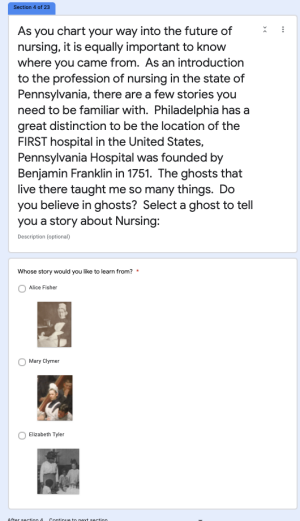Villanova Nursing Professor Uses Gaming Activities to Engage Students in Online Course

The virtual classroom can be a challenging learning environment for students. But Villanova professors are making extraordinary efforts to assure it’s an engaging one. Sunny Hallowell, PhD, PPCNP-BC, IBCLC, Assistant Professor of Nursing, looked for solutions using game theory.
Dr. Hallowell teaches Nursing and Health Policy, a senior level nursing course which aims to give nursing students fundamental knowledge of how health care policy is designed, structured, and implemented. Nursing students learn how health policy influences both their clinical practice and the potential health outcomes experienced by their patients. In this course, Dr. Hallowell is implementing game style activities to engage students with the subject matter on a deeper level while teaching online.
Throughout the course, readings are accompanied by a game-style narrative, which varies by week. In one example, students are on a mission to survive an escape room. To complete this mission, students must answer questions related to course readings of their choice.
“The games are designed to allow students to navigate their way to their own learning destination,” said Dr. Hallowell. “Various types of multi-media (e.g. readings, lay-literature, video) are used to engage students with the subject matter while at the same time encouraging them to making informed choices based on what they have just learned. Each choice provides an unfolding story-line that determines their learning destination, which is not typical of most reading assignments.”

Another game focuses on a student’s role in nursing. It features readings and multimedia in a choose your own adventure style, to help students journey through the history of nursing through to the present day. Students learn from influential nursing leaders, including: Florence Nightingale’s student Alice Fisher, reformer of the Philadelphia General Hospital; Mary Eliza Mahoney, the first African American Nurse; and Mary Clymer, featured in the famous painting “The Agnew Clinic” by Thomas Eakins. In the game, students voyage through time to understand their nursing legacy of social justice and the importance of their roles as health policy leaders and patient advocates.
Implementing games is part of Dr. Hallowell’s greater goal for this course: to teach future nurses how they can become patient and community advocates through health policy.
“Most nurses, and healthcare providers for that matter, know very little about health policy,” said Dr. Hallowell. "Recent events have demonstrated that all health care providers need a fundamental understanding of how the health system works and how their roles as providers influence the process of policy implementation. Students need to be provided a set of basic advocacy skills in order to be engaged in the process of health system design and leadership.”
With some research experience in gaming, Dr. Hallowell designed the course as a direct response to the challenges of virtual learning imposed during the current pandemic. Various elements of simulation can be implemented in a virtual learning environment and used to engage students.
“I relied on the use of multimedia resources—everything from film, art, and current events—so that students could learn from different points of view in nursing that were not mine,” said Dr. Hallowell.
“The most important thing I can do in the midst of a global pandemic is to cultivate a cohort of informed and engaged nurses who are prepared to chart the future of nursing practice and improve health care delivery to their patients,” added Dr. Hallowell. She hopes the games help students reflect on what they learned from the readings, begin to identify how they can use this knowledge and apply it to their practice.
“We need to empower our students to be able to understand the complex health care system, become the advocates they are called to be as nursing professionals and to lean into their roles as designers of the future of American health care.”
